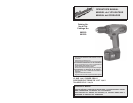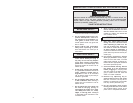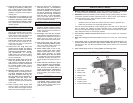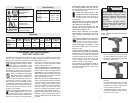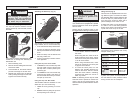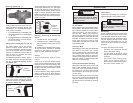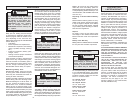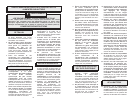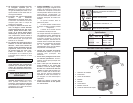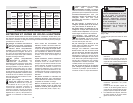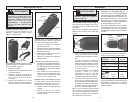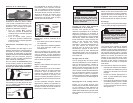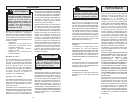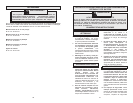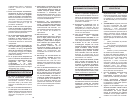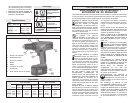
76
Inserting Battery Pack onto Tool
(Fig. 1 & 2)
Battery pack can be inserted onto the tool
in two ways.
1. For working in restricted spaces.
Insert the battery pack from the front
by sliding battery pack onto the body
of the tool. Insert the battery pack until
the battery latches lock.
Fig. 1
Remove the battery pack from the tool
for charging when the tool can no
longer perform its intended function
(i.e., drilling, cutting, etc.).
Leave the battery pack on the
charger after it has reached a full
charge; the pack will continue to re-
ceive a trickle charge to ensure capacity
is maintained.
Occasionally (once a week) leave the
batteries on the charger overnight to
help maintain cell balance.
Do not store the battery on the
charger (for more than 24 hours); this
could reduce battery life.
Never leave batteries on chargers
where power interruptions are com-
mon. Damage to the battery cells could
occur.
Store batteries at room tem-
perature away from moisture.
Do not store in damp locations
where corrosion of terminals may occur.
Do not submerge your battery or cord-
less tools in water. This will damage the
battery and tool.
Charge unused batteries overnight
at least every six months to maximize
battery life. Unused batteries discharge
at a rate of about 1% per day and will be
fully discharged after six months. For bat-
teries stored for a long time, two to ten
normal charging cycles may be required
before the pack is fully charged.
Do not use oil or solvents to clean or
lubricate your battery pack. The plastic
casing will become brittle and crack, caus-
ing a risk of injury.
2. For optimum weight distribution and
balance.
Insert the battery pack from the back
by sliding the battery pack onto the
body of the tool. Insert the battery pack
until the battery latches lock.
3. To remove the battery pack, press in
both battery latches and slide the bat-
tery pack off of the tool.
Fig. 2
WARNING!
Charge only MILWAUKEE 12, 14.4
and 18 Volt battery packs in
MILWAUKEE chargers. Other
brands of batteries may explode
causing personal injury and
damage.
For specific charging instruc-
tions, please read the operator's
manual supplied with your
charger.
Capacities
Steel
3/8"
1/2"
High Speed
Flat Bit in
Wood
7/8"
1"
Auger Bit
in Wood
1"
1-1/8"
Hole Saw
in Wood
1-1/4"
1-3/4"
Screws (dia.)
in Wood
1/4"
1/4"
Pathfinder
Bit
7/8"
1-1/4"
Cat. No.
0602-20
0612-20
Direct Current
Properly Recycle
Nickel Cadmium
Batteries
Symbology
Underwriters
Laboratories, Inc.
No Load Revolutions
per Minute (RPM)
Low Speed
Steel
3/8"
1/2"
Specifications
Cat. No.
0602-20
0612-20
Volts DC
12
14.4
No Load RPM
Low 0 - 400
High 0 - 1400
Low 0 - 400
High 0 - 1400
BATTERY PACK CARE AND USE
EXTENDING AND MAINTAINING
BATTERY PACK LIFE
Charge the new battery pack
overnight before use to allow
the cells to become fully
charged. New battery packs are not fully
charged. Two to ten normal charging/
discharging cycles may be required be-
fore the pack can take its maximum charge.
Never completely discharge
the battery pack. MILWAUKEE
battery packs do not develop a
"memory" when charged after only a par-
tial discharge. Taping-on triggers or leav-
ing work lights on for extended periods
to completely discharge the battery pack
will reduce its life by upsetting the electro-
chemical balance and can result in short-
circuiting of the battery.
Do not charge batteries in hot
or cold places (below 40°F (5°C)
or above 105°F (40°C)). Temperature
extremes reduce the ability for battery pack
cells to hold a charge. Do not store batter-
ies where the temperature may exceed
120°F (50°C), such as in a vehicle or metal
building during the summer.
To avoid overheating to a battery pack,
allow cordless tools cool down be-
tween high torque drilling/cutting
applications. The increased energy dis-
charge rate will heat the battery pack cells
faster than the cells can release the heat.
This could damage the cells.
After use, allow a hot battery pack to
cool to room temperature before inserting
it into the charger. If a hot battery is put on
a charger, charging will not begin until the
battery has cooled to a safe temperature.
See your charger manual for more infor-
mation on charging temperatures. Charg-
ing a hot battery will damage the cells.
Never forcibly heat up or cool down
batteries. This will damage some cells in
the pack, causing them to not be able to hold
a charge.
MILWAUKEE battery packs will operate for many years and/or hundreds of cycles when
they are used, charged, and stored according to these instructions. Properly using,
charging, and storing your battery pack can greatly extend its life.



